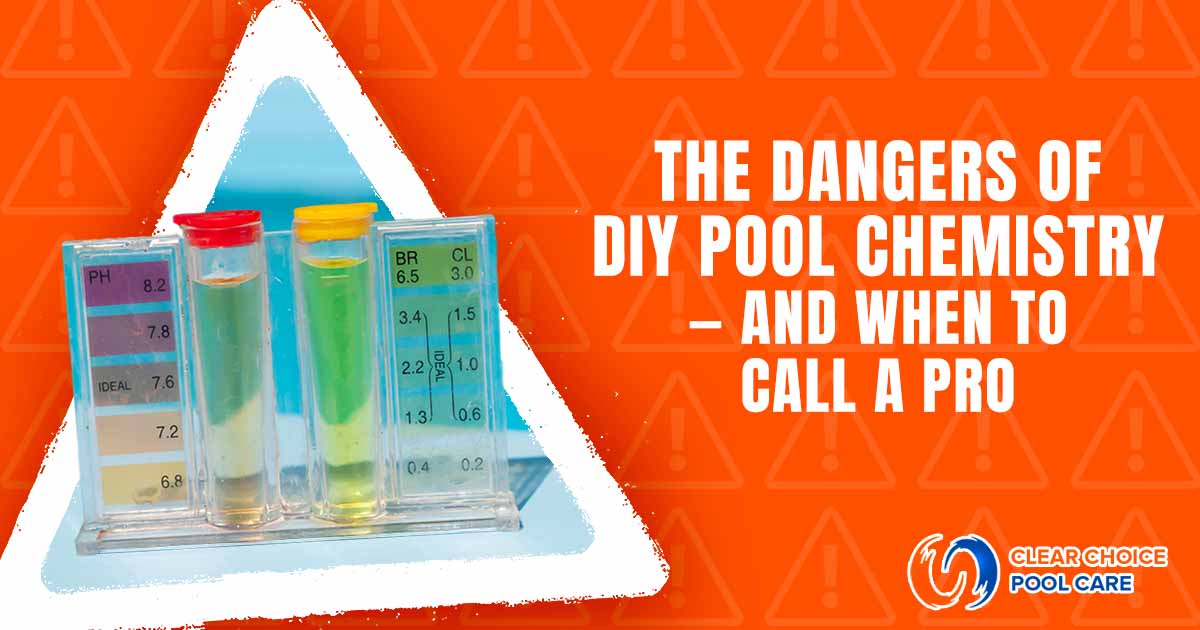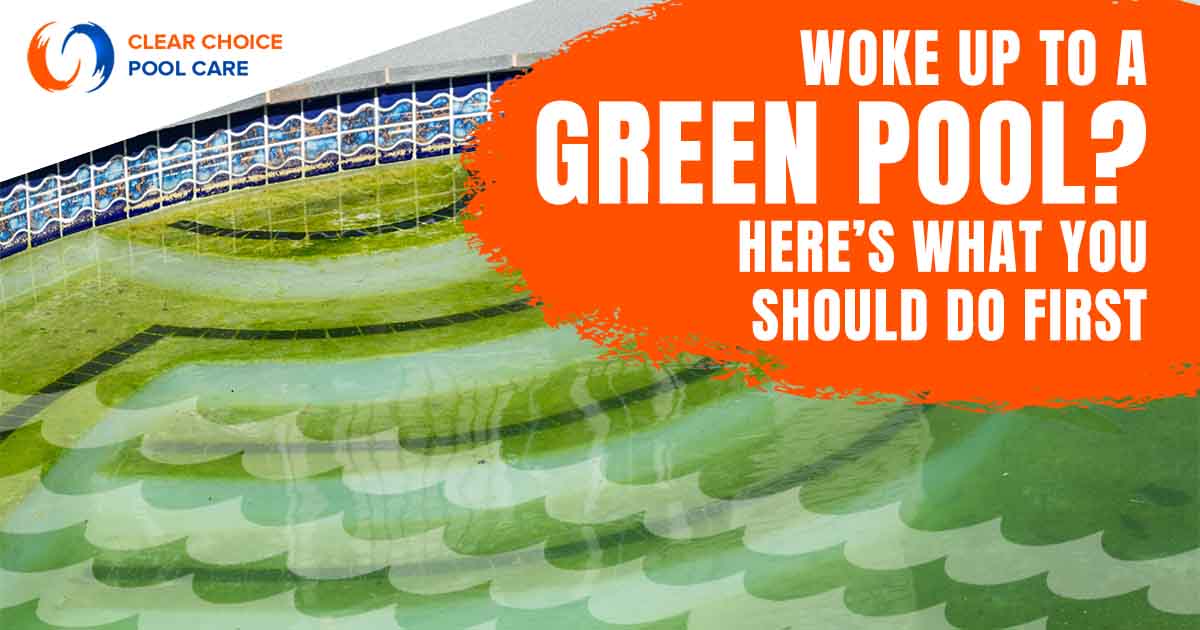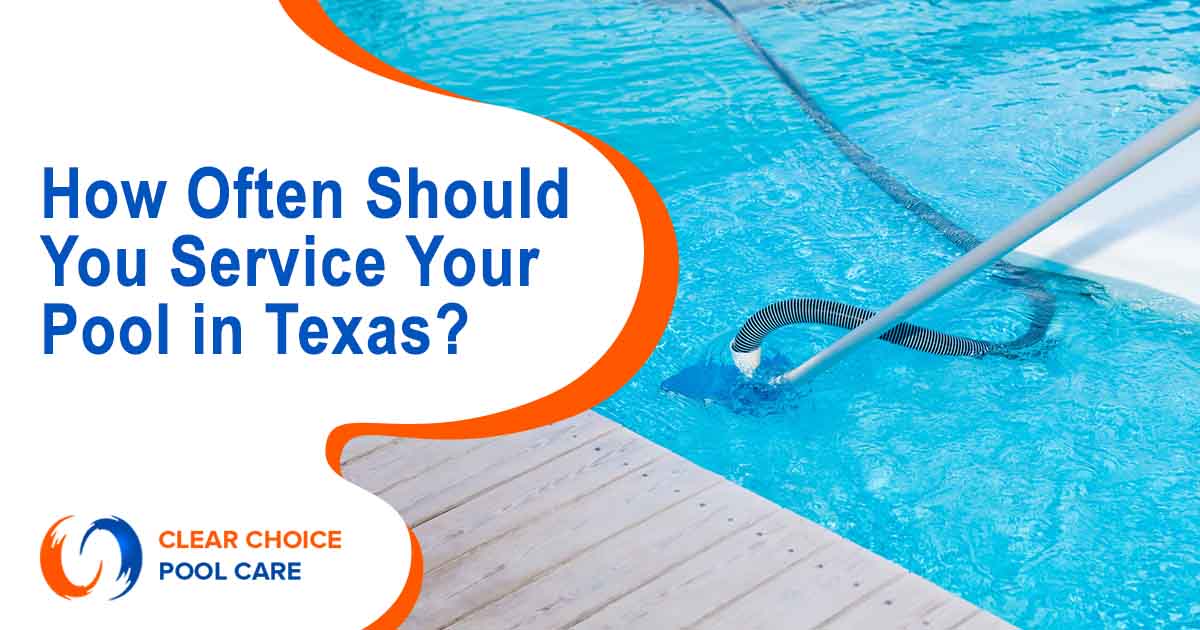Managing pool water chemistry at home may seem simple, but for many North Texas homeowners, it often leads to costly mistakes. It’s important to understand the dangers of DIY pool chemistry, including health risks, algae growth, and damage to expensive pool equipment. Homeowners who want consistent water quality and long-term protection for their investment should consider professional help.
Understanding DIY Pool Chemistry: What Most Homeowners Miss
Many pool owners in North Texas try to manage their pool’s chemical levels on their own, thinking it’s a routine part of weekly pool maintenance & services. They buy test strips or basic liquid kits and attempt to balance chlorine, pH, alkalinity, and calcium hardness themselves. However, DIY pool chemical balancing often results in inaccurate readings, poor chemical dosing, and inconsistent results over time.
One common misconception is that more chlorine means cleaner water. Another is assuming water looks safe just because it’s clear. Unfortunately, pool water chemistry is more complex. Without proper training, it’s easy to overlook imbalances that lead to algae, bacteria, and equipment corrosion.
The Appeal of DIY Pool Chemical Kits
There are several reasons homeowners choose to handle their pool chemistry themselves:
- They believe it saves money compared to hiring a pool service.
- DIY kits are widely available at home improvement stores.
- Online videos and forums make it seem manageable without training.
But without professional-grade testing and regular maintenance, even well-meaning efforts can cause long-term problems. For pools in North Texas—where heat and rainfall can swing chemical levels quickly—guesswork can lead to serious water quality issues.
The Hidden Risks of DIY Pool Chemistry Mistakes
Many homeowners don’t realize that small chemical miscalculations can lead to significant health, safety, and financial problems. DIY pool chemistry may appear manageable at first, but errors in testing or dosing can trigger a range of issues—from mild irritation to equipment failure and dangerous swimming conditions.
Over-Chlorination and Chlorine Burns
One of the most common mistakes with DIY pool chemical use is adding too much chlorine. High chlorine levels may irritate swimmers’ eyes and skin and can even cause mild chemical burns. Over-chlorinated water can also release strong fumes, making it unpleasant and unsafe to be near the pool.
Our service technicians have seen multiple examples where homeowners, thinking the pool looked cloudy or smelled “off,” and added extra chlorine daily. This led to corrosion of metal pool fixtures, discoloration of liners, and strong chemical odors that lingered for days.
Over time, the costs to correct the damage exceeded what a professional weekly service would have cost over the entire season.
Imbalanced pH and Its Chain Reaction
Even when chlorine levels are within range, the pH of pool water plays a critical role in maintaining safe and clean water. If pH is too low, the water becomes acidic, which can corrode metal components and cause skin irritation. If pH is too high, chlorine loses its effectiveness, and the water becomes a breeding ground for bacteria and algae.
Balancing pH requires understanding how it interacts with total alkalinity and calcium hardness. Inconsistent pH levels also accelerate wear on pool heaters, filters, and pumps.
Algae Growth from Inconsistent Testing
Algae outbreaks are often a direct result of inconsistent testing and unbalanced pool water. Homeowners may treat the pool once they see green or yellow stains forming, but by that time, the algae has already taken hold and is harder to remove.
In North Texas, high summer temperatures make algae growth more aggressive. Without routine, accurate chemical testing, even slight fluctuations in sanitizer levels or stabilizer concentration can create the perfect conditions for algae to thrive.
Clear Choice technicians regularly respond to calls from homeowners who spent hundreds of dollars on shock treatments and algaecides—only to have the problem return because the underlying chemical balance wasn’t addressed.
When DIY Pool Chemistry Damages Equipment
Incorrect pool chemistry doesn’t just affect the water—it can seriously damage pool equipment. Homeowners who rely on DIY pool chemical balancing often don’t realize how sensitive pool systems are to chemical levels, especially over time. Pumps, heaters, filters, and automatic cleaners are all vulnerable to corrosion, scaling, and premature failure when the water chemistry is off.
Chemical Scaling and Corrosion
High calcium hardness or improper pH can lead to scale buildup inside pipes, filters, and heaters. Scale reduces water flow and causes equipment to work harder, reducing energy efficiency and shortening the lifespan of components.
On the opposite end, water that is too acidic—often due to low pH or low alkalinity—can corrode metal surfaces and internal parts of your pool system. Corrosion may not be obvious at first, but it gradually leads to leaks, electrical issues, and system malfunctions.
Real-World Example: Heater Damage from Chemical Misuse
Clear Choice Pool Care recently serviced a home in North Texas where a new gas pool heater failed just eight months after installation. The homeowner had used a generic algaecide purchased online, unaware that it was incompatible with their heater’s copper components. Combined with a low pH level, the algaecide accelerated internal corrosion. The replacement cost exceeded $2,000—an expense that could have been avoided with regular professional maintenance.
Invisible Damage That Adds Up Over Time
DIY efforts often focus on the visible water quality—clear water, no debris, and no visible algae. However, improper chemical use can cause damage that isn’t seen until something breaks. Gaskets may dry out and crack, seals may degrade, and filter media may clog with residue from poor chemical mixing.
These issues are expensive and often occur suddenly, leading to service calls, downtime, and costly repairs.
Why Professional Pool Chemistry Services Make a Difference
Hiring a professional service like Clear Choice Pool Care for weekly pool maintenance offers peace of mind that DIY pool chemistry can’t match. Professionals use advanced testing equipment, understand how chemical levels interact, and adjust treatments based on real-time pool conditions—something most homeowners can’t do with store-bought kits.
More Accurate Testing and Monitoring
DIY test kits often rely on color comparisons, which are prone to user error. In contrast, professional technicians use digital meters and titration-based methods that provide precise readings for pH, chlorine, alkalinity, stabilizer (CYA), and calcium hardness. This accuracy ensures the right balance every time—preventing under-treatment or over-treatment.
Professionals also keep detailed records of past readings and seasonal trends, allowing them to adjust chemistry before a problem occurs. This proactive approach is especially important in Texas, where high temperatures and stormwater runoff can change pool chemistry quickly.
Balanced Water for Swimmers and Equipment
Water that is properly balanced does more than just look good—it’s safer for people and equipment. Professionals ensure:
- Free chlorine levels are effective for sanitizing
- pH stays within the ideal 7.4–7.6 range
- Alkalinity buffers pH swings
- Calcium levels prevent corrosion or scale
- Stabilizer (CYA) protects chlorine from UV breakdown
By keeping these levels in check, professional services protect both swimmers’ health and the integrity of your pool’s infrastructure.
Chemistry Adjustments Based on Local Conditions
North Texas pools face unique challenges—high heat, heavy use in summer, and unpredictable rainwater dilution. These factors can throw off chemical levels quickly. Clear Choice Pool Care tailors its chemical maintenance plans to regional conditions, helping homeowners avoid the common problems that come with one-size-fits-all DIY approaches.
Signs It’s Time to Stop DIY Pool Chemistry
Many homeowners continue with DIY pool chemistry until clear signs of trouble appear. By then, the damage may already be costly to fix. Recognizing the early warning signs can help prevent larger issues and protect your investment.
Water Clarity Never Lasts
If your pool looks clean one day and cloudy the next, it’s a sign the chemical balance isn’t stable. Even with regular chlorine use, imbalances in pH, alkalinity, or stabilizer can cause fluctuations that affect clarity and safety.
Skin or Eye Irritation After Swimming
Frequent complaints of burning eyes or itchy skin are often linked to incorrect chlorine or pH levels. This discomfort is preventable with consistent chemical maintenance from a trained professional.
Recurring Algae Problems
If algae keeps coming back even after shocking the pool, it’s likely due to imbalanced or ineffective sanitization. Improper stabilizer or chlorine levels are often to blame, and repeated outbreaks can permanently stain pool surfaces.
Pool Equipment Shows Signs of Wear
Discoloration, rust, mineral deposits, or premature part failures often point to chemical misuse. DIY maintenance can miss the slow chemical damage occurring inside pipes, filters, and heaters.
You’re Guessing Instead of Measuring
If you find yourself adjusting chemicals based on appearance or “feel” rather than accurate testing, it’s time to call a pro. Guesswork is one of the biggest causes of long-term pool damage—and it’s entirely avoidable.
How a Weekly Maintenance Plan Takes the Guesswork Out
For homeowners who are unsure about managing their pool’s water balance, a weekly service plan offers consistency, reliability, and expert oversight. Clear Choice Pool Care provides a full-service weekly maintenance program designed to eliminate the risks of DIY pool chemistry.
What’s Included in Weekly Pool Service
Clear Choice’s weekly service covers every critical aspect of chemical maintenance, including:
- Accurate water testing using professional-grade equipment
- Precise chemical dosing based on test results
- Adjustment of chlorine, pH, alkalinity, stabilizer (CYA), and calcium levels
- Monitoring of seasonal and usage changes that impact water chemistry
- Documentation of water trends and maintenance history
This approach not only ensures swimmer safety, but also protects pool surfaces, plumbing, and equipment from the silent damage caused by poor water balance.
More Than Just Chemical Balancing
In addition to chemistry, the weekly service includes debris removal, skimmer basket checks, filter inspections, and visual equipment assessments. It’s a comprehensive solution that helps prevent costly repairs while giving homeowners more time to enjoy their pool.
Cost vs. Long-Term Value
Many homeowners believe they save money by buying test kits and chemicals themselves. But when adding up the cost of kits, algaecides, shock treatments, and the time spent troubleshooting cloudy or green water—DIY quickly becomes more expensive.
Factor in the potential cost of replacing corroded heaters, damaged filters, or resurfacing a stained pool, and a professional maintenance plan becomes the smarter investment.
Ready for a Clearer Pool? Schedule Your Water Chemistry Check Today
Call Clear Choice Pool Care at (469) 312-6670 or fill in the contact form to request a professional water chemistry check or get started with weekly pool service.
Don’t wait for algae blooms, cloudy water, or damaged equipment—take the guesswork out of pool care with trusted, local experts serving North Texas.





